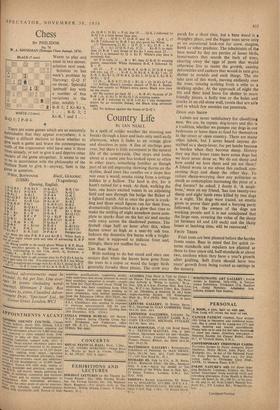Chess
BY PHILIDOR
No. 78 W. A. SIONKMAN (Dubuque Chess Journal, 1870) WIIITE (12 men)
11.-Q 5; 2 P-B 4. WHITE to play and mate in two moves: solution next week.
Solution to last week's problem by Hartong: Q-Q 8! no threat. Splendid 'ambush' key with a number of fine variations in the play, notably I . . B-B 3; 2 Kt-Kt 6, I . . B-K 3; 2 Kt-K 7 and 1 . . .
There are some games which are so eminently Publishable that they appear everywhere; it is always a difficult decision to know whether to give such a gan'te and brave the contemptuous spas of the cognoscenti whd have seen it three tittles already, or not to give it and deprive other readers of the 'game altogether. It seems to me to be in accordance with the philosophy of the Welfare State to give it—anyway, here is the game in question.
White, BOTWINNIK Black, GLIGORIC
(USSR) (Yugoslavia)' Opening, English.
;
„I Q s 4 P-K 13 Kt 3 16 K-(19 B-K 1 2 (e) ' . P-K Kt 3 P-Q 4 17 Q-Kt 7 K-Q
' ,,,B-Kt 2 B-Kt 2 18 P-B 4 Q-K 2 , Kt-Q 8 3 Kt-Q B 3 19 R-R 1 Kt-QI
,-' Itt-0 3 Kt-R 3 (a) 20 Kt Kt 41 K-B 2
2 P-K R 41 P-Q 3 21 R-R 8W) B-B 3
p...Q 3 R-() Kt I 22 Kt-B 61 (g) K-Kt 3 8 P--R 5 B-Q 2? (b) 23 B x B Kt x B(h) 9 It x Kt B x B 24 R-R 7 Kt-Q 1 (i)
la P x P RP x P 25Q x KtP K-R 3
R Q-„. 13 11 B-Kt (J) R 4
-•.‘ X R ch B x R 27 Q-Kt 5 K K- x P jaQ-R 6 B x Kt (c) 28 R-R I K-Kt 6 k)
15 x 13 P,-K 3 29 Q-R 4 K-Kt 7 (I)
'' Kt-Kt 5 K-K 2 (d) 30 P-Kt 4 Resigns (m) , (0 With the idea P-K B 4 and Kt-B 2. White finds a 'erY fine reply which puts any idea of advancing K B P °m of court.
( te) Being unable to des o much out White K R Pt Black thine sensibly) ignor it. Thaisb move, as White s next 'sneves, culminating t in the 11th, show, is, however, a u istake; 8 , .. 13-K 5 is „ (e) Hoping later to get counter play by P-Q Kt 4, but he 4.1511`er gets time for this. The alternative is B-13 3, but White - gels a marked advantage with Kt-K Kt 5, threat Q-R 7. (d) l5 .. . Q-B 3; loses to 16 Kt-K 4, Q-K 2; 17 Q-R 8 tss,,,,,..
ch, Q-B 1; 18 Kt x P ch, but 15 Q-K 2 followed by
K-Q I is a little better than text. (e) 16 . . . 0-13 1; 17 Q-R 4! and 16 . . . Q-R 17 Kt-ft 7 followed by R-R I are also good for White. (f) Threatening 22 Kt x Q P, Q x Kt; 23 R x B or 22 ... K x Kt; 23 Q-K 5 ch. If 21 ... Kt-B 3; in reply then 23 R-R 7 and threat of Kt-Kt 5 wins since 23 . . . Kt-Q 1; is defeated by Q x. Kt P. White's play here is extremely line. (g) If in reply 22 — B x 137; then 23 R-K 8! winning queen; meanwhile White threatens B-K 4 followed by ©x P. (It) 23 , . . P X 13; 24 R-K 8, Q-B 2; 25 Q-B 8 and will win, e.g. 25 . . K-R 3; 26 Kt-K 4, R-Kt 7 ch: 27 K-K 3, Kt-Kt 2; 28. R-B 8, Q-Kt 3; 29 Q-K 8, Kt-ft 4; 30 Kt x Q P.
(I) 24 ... R-K 13 17; 25 Q x RI, Q x Q; 26 Kt-Q 7 ch. (j) Killing Black's counter chance of P-Kt 4. Rather than lose quietly to White's extra pawn, Black now runs on the sword.
(k) He cannot go back 28 . K-R 47; because of 29 R-R I ch, K-Kt 3; 30 Kt-Q 5 ch winning queen. (I) R-ft 1 followed by Q-R I-Q Kt I was threatened: drawn by an invisible throad, the Black king advances again. (m) No defence against the threat of Q-Q I.


















































 Previous page
Previous page